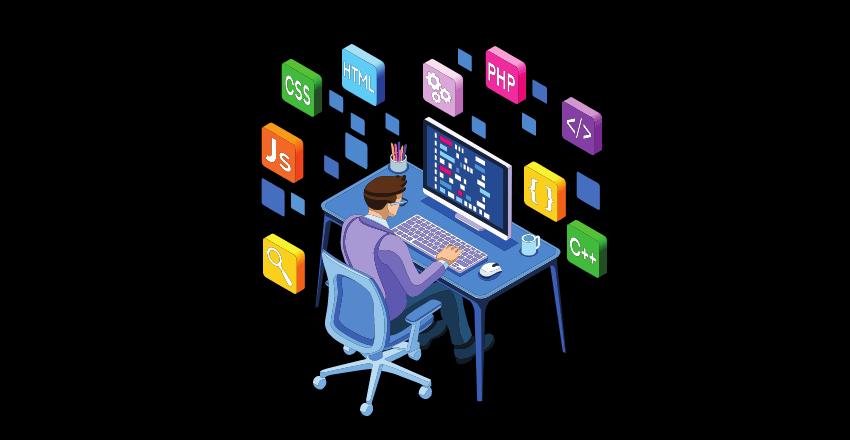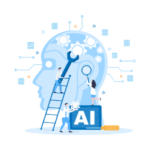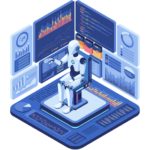
CTOs guide to introducing AI: Blending cutting-edge technology into business ecosystems, a transformative journey towards unparalleled operational efficiency begins.
Welcome to the CTOs guide to introducing AI into your software projects. As a CTO, you play a crucial role in integrating AI into software projects effectively. However, introducing AI is easier said than done, and it requires careful consideration of various factors to ensure successful implementation.
This article will guide you through the process of integrating AI into your software projects and provide you with insights on how to overcome implementation challenges and maximize return on investment (ROI).
This guide will also help you identify the right AI solutions and build an AI-ready team to support AI integration.
Before we delve into the specifics of introducing AI into your software projects, let’s first understand the benefits that AI brings to software projects and the important factors to consider before implementing it.
Understanding the Benefits of AI in Software Projects
Artificial Intelligence (AI) has revolutionized the way in which businesses operate, and software development is no exception. By leveraging machine learning algorithms and predictive analytics, AI helps businesses improve efficiency, accuracy, and innovation.
Here are some of the key benefits of incorporating AI into your software projects:
| Benefits of AI in Software Projects |
|---|
| Improved accuracy: AI algorithms can quickly analyze large datasets and accurately predict outcomes, reducing the likelihood of errors. |
| Increased efficiency: AI can automate repetitive and time-consuming tasks, allowing developers to focus on higher-level tasks. |
| Enhanced innovation: AI can analyze patterns and trends to provide insights that can be used to innovate and improve software projects. |
| Personalization: AI can be used to personalize content and user experience, improving customer satisfaction and retention. |
By incorporating AI into your software projects, you can gain a competitive edge, increase productivity, and optimize your operations.
Key Considerations for CTOs Before Introducing AI
Before implementing AI in software projects, CTOs must consider several important factors to ensure successful integration.
Here are some key considerations to keep in mind:
Data Privacy
One of the primary concerns with AI implementation is the protection of sensitive and confidential data. It is crucial to have a comprehensive data privacy plan in place to ensure compliance with data protection laws and regulations. CTOs must work with their team to establish protocols to safeguard data and ensure transparency with users.
Ethical Considerations
CTOs must also consider the ethical implications of AI integration. They should be aware of potential biases in the data and algorithms used in AI solutions and ensure that they do not perpetuate discrimination or inequality. Establishing an ethical framework for AI usage can help mitigate these risks.
Resource Requirements
Integrating AI into software projects requires significant resources in terms of time, money, and personnel. CTOs must determine if they have the resources necessary to support AI integration. If not, they may need to consider outsourcing AI implementation or acquiring additional resources.
Impact on Existing Systems
Before implementing AI, CTOs must assess the impact it will have on existing systems. They must ensure that the integration of AI does not negatively affect other functionalities or cause disruptions. CTOs should work closely with their team to establish a plan to minimize any adverse effects.
By considering these key factors, CTOs can proactively address potential obstacles and ensure successful AI integration into their software projects.
Identifying the Right AI Solutions for Your Software Projects
Integrating AI into your software projects requires careful consideration of the right solutions that meet your project needs and goals. Here are some key factors to consider when identifying the right AI solutions:
Understand Project Goals
The first step towards identifying the right AI solution is to understand your project goals. Define what you expect to achieve with the integration of AI, such as faster processing times, improved accuracy, or enhanced user experience. Having a clear goal in mind will help you to focus on finding the right AI solution.
Evaluate Available Options
Next, evaluate the different AI options available in the market. Consider factors such as functionality, ease of use, cost, and scalability. This will help you to create a shortlist of potential AI solutions that meet your project requirements.
Conduct Thorough Research
Once you have identified potential AI solutions, conduct thorough research on each of them. Check for reviews, case studies, and customer feedback to gain insights into their performance and effectiveness. Additionally, consider factors such as data privacy compliance, vendor support, and maintenance requirements when making your decision.
Consider the Integration Process
During the identification of the right AI solutions, it is essential to consider the integration process. Determine how easy or complex it is to integrate the selected solution with your existing software and systems. Choose an AI solution that integrates easily and seamlessly with your software and systems.
By following these guidelines, you can identify the right AI solutions that meet your project requirements and help you achieve your desired outcomes.
Overcoming Implementation Challenges – CTOs guide to introducing AI

Implementing AI in software projects can be challenging, and CTOs must be prepared to address the potential roadblocks along the way. Here are some strategies to overcome implementation challenges and achieve successful AI integration.
Manage Data Quality
One of the biggest challenges with AI implementation is ensuring the quality of the data being used. CTOs need to establish data standards and ensure that the data is accurate, consistent, and reliable. This can be done by implementing data cleansing processes, data validation checks, and data profiling.
Address Technical Limitations
Another challenge is managing technical limitations, such as compatibility issues with legacy systems or ensuring that the AI solutions used are scalable and adaptable. CTOs need to work with their team to identify these limitations and develop strategies to address them. This might include upgrading technology platforms, investing in additional hardware or software, or working with external vendors.
Foster a Culture of Adoption
Finally, CTOs need to work to foster a culture of adoption within their organization. This means ensuring that employees are properly trained on the AI technology being used, and that they are comfortable with the changes being introduced. To achieve this, CTOs should establish clear communication channels, provide ongoing training and support, and create incentives for employees to embrace the technology.
“Implementing AI in software projects can be challenging, and CTOs must be prepared to address the potential roadblocks along the way.”
Maximizing ROI with AI Integration – CTOs guide to introducing AI
Integrating artificial intelligence (AI) into software projects can be a significant investment. To maximize return on investment (ROI), CTOs must consider several key factors.
Set Clear Goals and Metrics
Before implementing AI, define clear goals and metrics to measure success. This will enable you to evaluate the impact of the technology on your software project and determine whether it has achieved the desired ROI.
You should identify and track the following metrics:
- The accuracy of AI-powered systems
- Cost savings and increased efficiency
- Improvements in customer satisfaction
By establishing a baseline for each metric before implementing AI, you can compare it to the results after implementation to determine its success.
Continuously Improve AI Integration
Maximizing ROI with AI integration requires continuous improvement. CTOs should seek to optimize their AI-powered systems by either refining its algorithms or exploring other AI solutions. AI technologies also evolve at a rapid pace, so keeping up to date will ensure that your systems remain cutting-edge.
Furthermore, collect feedback from users of the systems and use it to modify and enhance the AI-powered features. Continuous improvement will not only maximize ROI but also keep users engaged and satisfied.
Implementing AI: Best Practices and Case Studies
Successfully integrating AI into software projects requires careful planning, attention to detail, and a strong team. In this section, we will explore some best practices for implementing AI and highlight real-life case studies that provide insight on how to do it successfully.
Best Practices for AI Integration
Implementing AI involves navigating a complex landscape of technical considerations, organizational structures, and ethical concerns.
Here are some best practices to guide you:
- Start small: Begin with a small, manageable project that can demonstrate the value of AI before scaling up to more ambitious initiatives.
- Engage stakeholders: Involve all relevant stakeholders, including end-users, developers, and business leaders, in the planning and implementation process.
- Address data quality: Ensure that data is clean, accurate, and representative of the problem you are trying to solve. Garbage in, garbage out!
- Foster a culture of adoption: Encourage adoption of AI technologies by building trust, providing training, and emphasizing the benefits of AI for all involved.
- Measure success: Define clear metrics to measure the success of your AI implementation and continuously evaluate your progress to make improvements as necessary.
Examples: Successful AI Integration in the Real World
Let’s take a look at some real-life case studies that demonstrate successful AI integration:
| Company | Case Study | Result |
|---|---|---|
| UPS | Optimizing Delivery Routes with AI | Reduced delivery time by 10 million minutes per year, saving $400 million annually |
| Macy’s | Smart Fitting Rooms with AI | Increased customer engagement and sales by providing personalized recommendations and streamlined checkout options |
| IBM | AI-Enabled Customer Service | Improved customer satisfaction and reduced response times by implementing AI-powered chatbots to handle customer inquiries |
“These case studies demonstrate the potential of AI to transform business operations and improve customer experiences. By following best practices and learning from successful implementations, you can harness the power of AI to achieve similar results.”
Building an AI-Ready Team – CTOs guide to introducing AI
Integrating AI into software projects requires a team of skilled and knowledgeable professionals. As a CTO, it is your responsibility to build an AI-ready team to ensure the success of your project. Here are a few strategies to help you build an effective team:
Identify Skill Gaps
Before you start building your team, you need to identify the specific skills required for your AI project. This will help you determine the skill gaps in your current team and plan for any necessary hiring or training. You may need to hire data scientists, software engineers, or machine learning experts to fill these gaps.
Foster a Learning Culture
As AI technology continues to evolve, it’s important to foster a culture of continuous learning within your team. Encourage your team members to attend conferences, workshops, and training sessions to stay up to date with the latest advancements in AI technology. Additionally, allocate time for team members to experiment with new tools and techniques.
Leverage External Resources
If you don’t have the necessary skills within your current team, consider outsourcing or partnering with external resources. You can hire consultants or engage with AI service providers to help you with specific tasks or projects. This can save you time and resources while still ensuring you have access to the necessary expertise.
By building an AI-ready team, you can ensure that your software projects are successful in integrating AI technology. With the right team in place, you can capitalize on the benefits of AI and drive innovation within your organization.
Frequently Asked Questions – CTOs guide to introducing AI

As CTOs consider integrating AI into their software projects, they may have questions regarding the implementation process, benefits, and potential challenges. Here are some common questions and their answers:
Q: What are some benefits of integrating AI into software projects?
Integrating AI into software projects can enhance efficiency, accuracy, and innovation. It can automate repetitive tasks, analyze data more quickly and accurately, and provide insights that may not be visible to the human eye.
Q: What are some potential challenges of integrating AI?
Some potential challenges include managing data quality, addressing technical limitations, and fostering a culture of adoption. It is important to develop a solid plan for implementation and to have a team with the necessary skills and knowledge to support the integration process.
Q: How do I identify the right AI solutions for my software project?
It is important to understand your project goals, evaluate available options, and conduct thorough research. Look for AI solutions that align with your project goals and have a proven track record of success in similar projects.
Q: How can I ensure a positive ROI with AI integration?
Measuring key metrics and continually evaluating and improving the integration process can contribute to a positive ROI. Also, gathering user feedback and incorporating it into the integration process can lead to a more successful outcome.
Q: How can I build an AI-ready team?
Identify skill gaps within your team and provide training and resources to fill these gaps. Foster a learning culture and encourage team members to stay up to date on AI developments. Consider leveraging external resources, such as consultants or contractors, to supplement your team’s existing skills.
Q: What are some successful case studies of AI integration in software projects?
There are many successful case studies of AI integration, including the use of AI in healthcare to improve patient outcomes and in finance to detect fraudulent behavior. It is important to conduct research and identify case studies that align with your project goals and industry.
Benjamin Bale is a distinguished expert in the field of AI development and an esteemed author for the “Hire AI Developer” blog. With a remarkable decade-long experience in the industry, Benjamin has cemented his reputation as a leading authority in AI app and website development, as well as AI backend integrations. His profound passion for AI and its transformative potential is evident in every aspect of his work.
Benjamin’s journey into the world of AI began at Edinburgh University, where he pursued his studies in AI and Mathematics. It was during this time that he cultivated a deep understanding and fascination for the subject. Throughout his career, Benjamin has accumulated extensive experience working with industry giants such as Goldman Sachs, Tencent, and Ali Express. These invaluable experiences have not only sharpened his skills in integrating existing systems with AI APIs but have also solidified his status as a consummate professional in the field.
Currently residing in the vibrant city of London, Benjamin finds solace in his role as both an author and developer. Beyond his professional endeavors, he takes great joy in the company of his faithful canine companion, Chad, and indulges his passion for snowboarding in the picturesque mountains of France. Benjamin’s unwavering dedication to advancing AI technology, combined with his wealth of knowledge and practical expertise, make him an invaluable asset to the “Hire AI Developer” team and an invaluable resource for readers seeking profound insights into the realm of AI.







